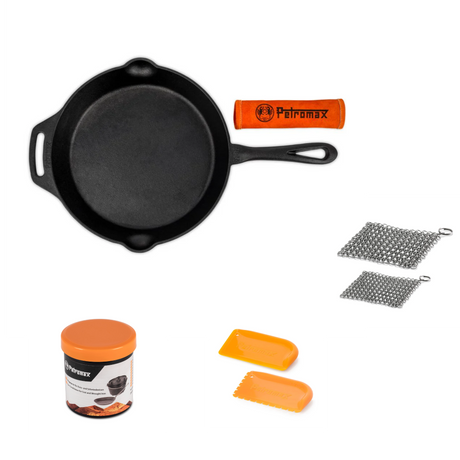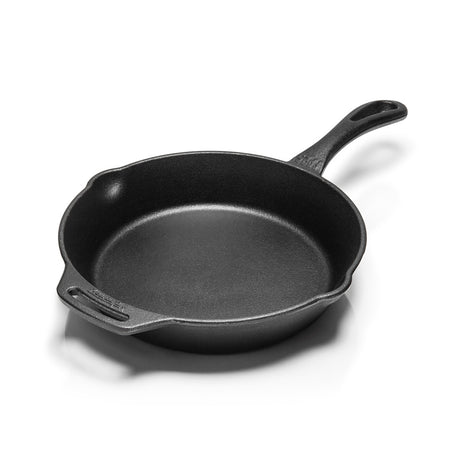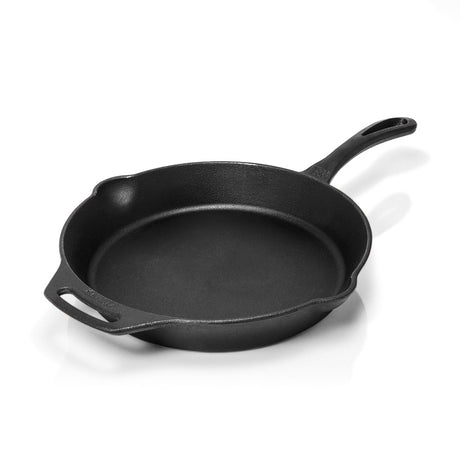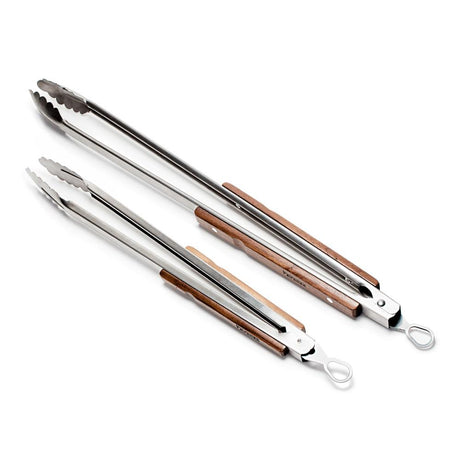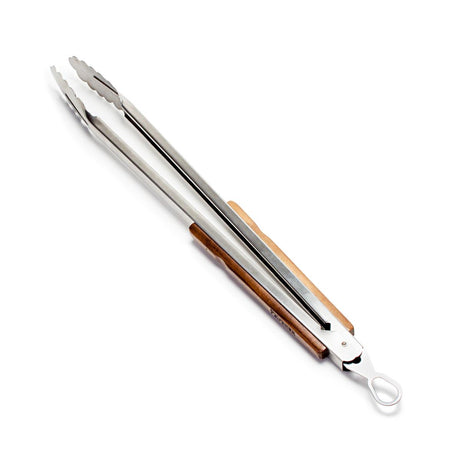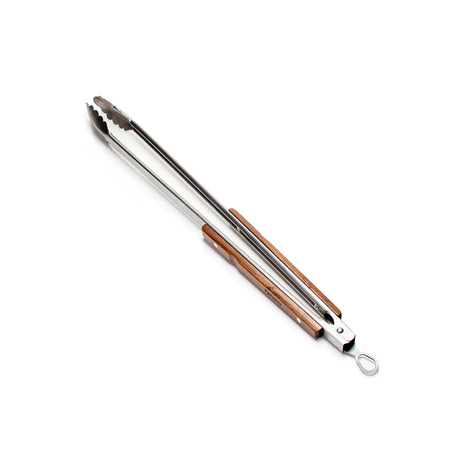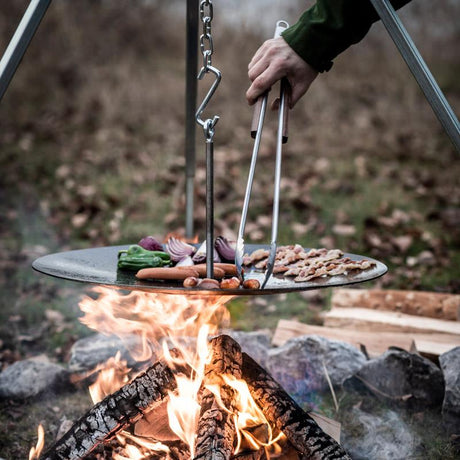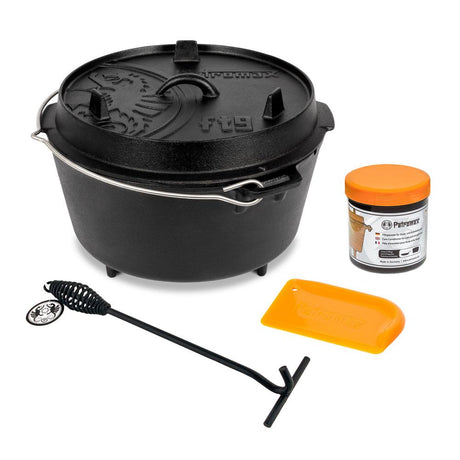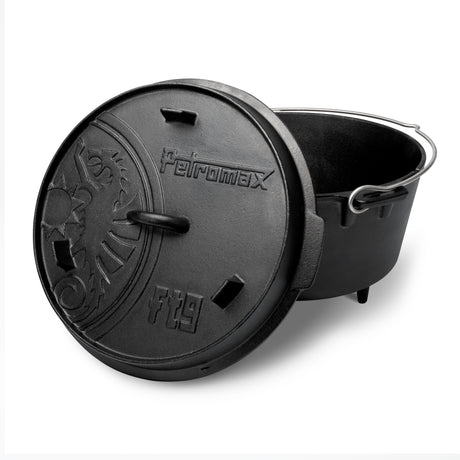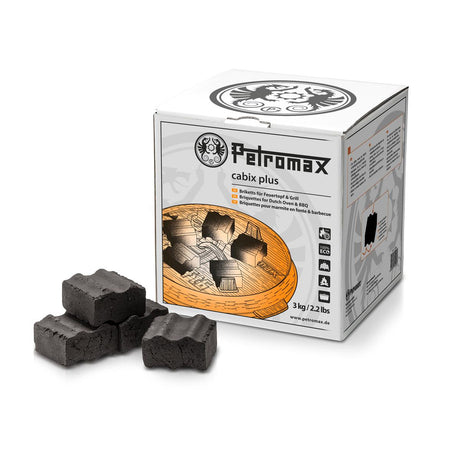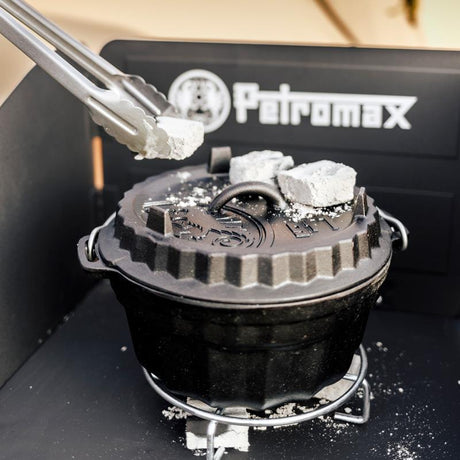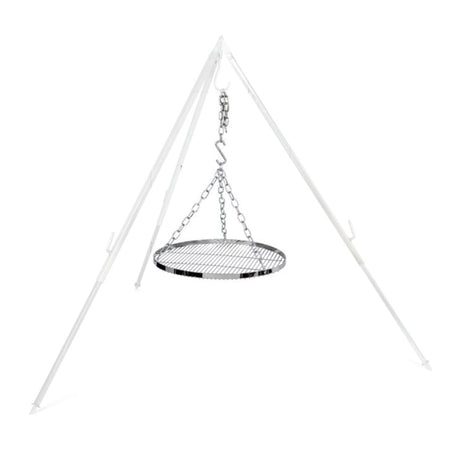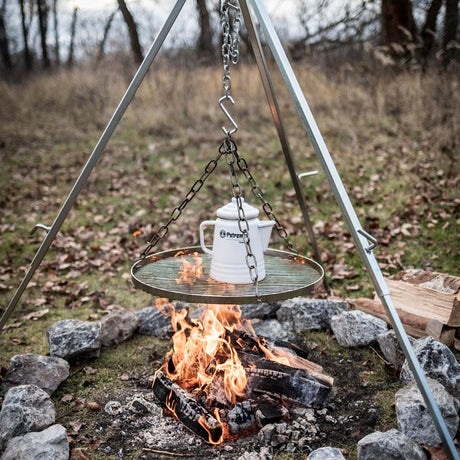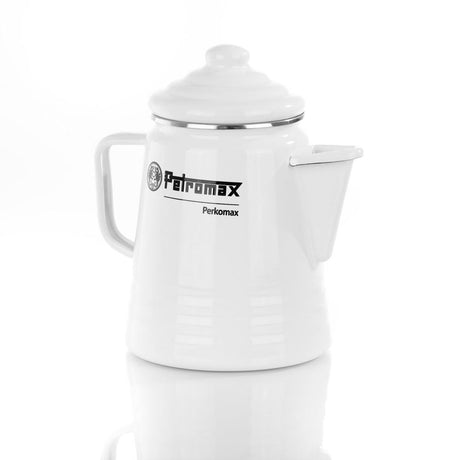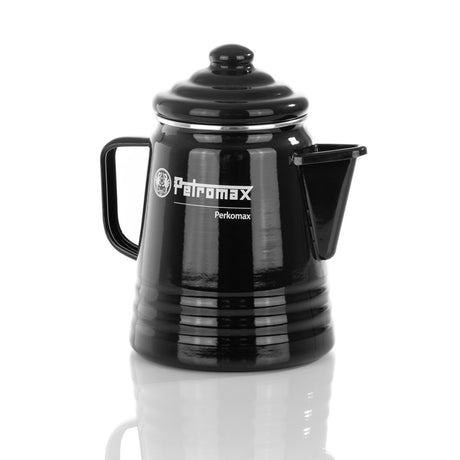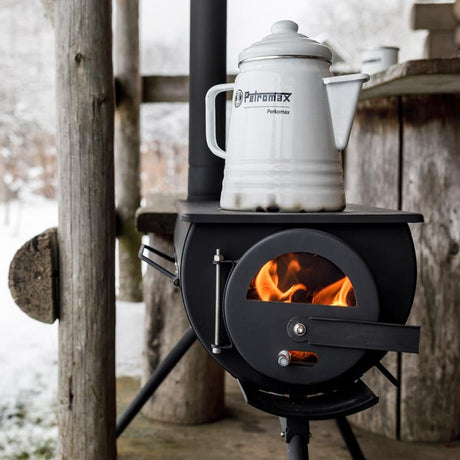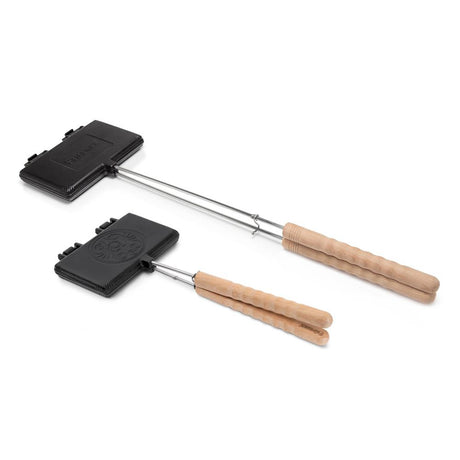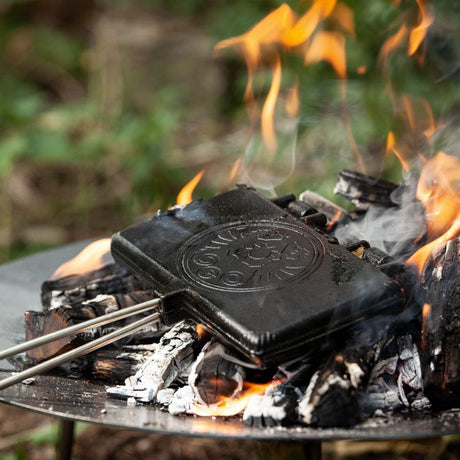Are you planning an outdoor kitchen or would you like to expand your existing equipment? Then you are probably faced with the question: cast iron or stainless steel? Both materials have their own strengths, and we can help you find out which suits your outdoor cooking style best. In this guide, you'll find out everything you need to know about the advantages and disadvantages of both materials.
Table of contents
Introduction to cast iron and stainless steel
Why choosing the right material is important
Properties of cast iron
Properties of stainless steel
Use in the outdoor kitchen
Cast iron vs. stainless steel: the comparison
Conclusion and recommendations
Introduction to cast iron and stainless steel
The history of cast iron in the kitchen dates back to the Middle Ages. Even back then, people appreciated the special properties of this robust material. Cast iron is created by melting down pig iron and other metallic components, creating a material with unique properties. The characteristic black color and the high weight are only the most obvious features.
Stainless steel, on the other hand, is a child of the modern age. First developed at the beginning of the 20th century, this corrosion-resistant material revolutionized the kitchen world. As an alloy of various metals, primarily iron and chrome, stainless steel offers a unique combination of durability and ease of care. Its shiny surface is not only visually appealing, but also particularly hygienic.
Why choosing the right material is important
Choosing the right material not only influences the cooking results, but also the longevity of your outdoor kitchen. Factors such as weather resistance, maintenance requirements and cooking properties play a decisive role in the decision. The decision between cast iron and stainless steel has far-reaching consequences for your outdoor kitchen. The material not only influences the way you can cook, but also the long-term maintenance requirements and durability of your kitchen equipment.
The demands placed on kitchen utensils are particularly high in outdoor areas. Wind and weather affect the materials, and large temperature fluctuations put their resilience to the test. Added to this are the special challenges of outdoor cooking: high temperatures when grilling, long cooking times when Dutch oven cooking or rapid temperature changes when flambéing - all of these factors must be taken into account when choosing materials.
Economic aspects also play an important role. While the purchase costs may differ for the two materials, the long-term maintenance and replacement requirements must also be taken into account.

Properties of cast iron
Typical areas of application
Cast iron has established itself in outdoor cooking, especially where even heat distribution and robustness are important. The classic Dutch oven is probably the best-known example of the versatility of this material. It can be used to prepare stews, roasts and even bread. Cast iron is also a popular material for pans and grill grates, as it enables perfect roasting results and gives the food its characteristic roasted aromas.
Cast iron is particularly popular for
- Roasters and pans
- Dutch ovens
- grill grates
- Plancha plates
Heat storage and distribution
One of the most outstanding properties of cast iron is its ability to store heat and distribute it evenly. Although the material heats up more slowly than aluminum or stainless steel, for example, it retains the temperature much longer. This property makes it particularly valuable for stews and slow cooking processes. The even heat distribution prevents the formation of hot spots, i.e. overheated areas that could burn the food.

Robustness and durability
The proverbial robustness of cast iron is legendary. The material not only withstands extreme temperatures without deforming, but also improves with regular use. Over time, a natural patina forms, the so-called seasoning layer, which not only ensures excellent non-stick properties, but also protects the material. Properly cared for, cast iron utensils can be passed down through generations without any problems.
With the right care, cast iron can last for several generations. The material is:
- Extremely robust against mechanical stress
- Insensitive to high temperatures
- Practically indestructible with good care

Care and cleaning
Although the care of cast iron requires a little more attention than stainless steel, it is by no means complicated. The most important thing is to prevent rust from forming and to maintain the protective patina. Cleaning and caring for cast iron primarily means cleaning the material thoroughly after use and drying it well. A thin layer of oil should then be applied to protect the surface. It is important to avoid aggressive cleaning agents and the dishwasher, as these can damage the protective patina.
You can find detailed instructions on cleaning and caring for cast iron here.

Properties of stainless steel
Typical areas of application
Stainless steel is ubiquitous in the modern outdoor kitchen. Its versatility makes it the ideal material for work surfaces where hygiene and ease of care are paramount. Stainless steel is also the material of choice for cooking pots and kitchen utensils when it comes to rapid temperature changes and uncomplicated handling. Stainless steel shows its strengths particularly when preparing acidic dishes such as tomato sauces or marinating.
Stainless steel is often used in:
- work surfaces
- saucepans
- barbecue accessories
- Storage systems
Corrosion resistance
The outstanding corrosion resistance of stainless steel is based on a self-healing passive layer of chromium oxide that forms on the surface. This microscopically thin layer protects the material from external influences and makes it particularly resistant to weathering and aggressive substances. Even if the surface is damaged, this protective layer forms again immediately when exposed to oxygen. This property makes stainless steel particularly valuable for outdoor use, where the material is exposed to wind and weather.
Stainless steel impresses with:
- High resistance to rust
- Insensitivity to acids and alkalis
- Weather resistance

Weight and handling
The significant weight advantage of stainless steel over cast iron makes it particularly practical in everyday use. Pots and pans are easy to move and transport, which is a particular advantage in an outdoor kitchen where cooking utensils often have to be moved around. The lighter weight also has a positive effect on cleaning. The smooth surface also makes it easy to handle the food, as nothing sticks or collects.
Compared to cast iron, stainless steel is
- Significantly lighter
- Easier to transport
- More flexible to use

Easy to clean
Stainless steel is extremely easy to care for . The smooth, non-porous surface is easy to clean and is largely resistant to common cleaning agents. Unlike cast iron, stainless steel can be cleaned in the dishwasher without hesitation. Even stubborn stains can usually be removed easily without damaging the material. Care should only be taken when using steel wool or highly abrasive cleaning agents, as these can cause scratches.
Stainless steel scores with:
- Easy cleaning
- Dishwasher-safe
- Low maintenance

Use in the outdoor kitchen
Cast iron as an outdoor all-rounder
In the outdoor kitchen, cast iron shows its full strength as a versatile cooking material. The robust cast iron shapes are ideal for a wide variety of outdoor cooking methods. Whether direct grilling over an open fire, indirect cooking in a Dutch oven or roasting on a plancha - cast iron masters these challenges with flying colors. Its excellent heat retention makes it particularly valuable when cooking outdoors, where gusts of wind and fluctuating outside temperatures can make temperature control difficult.
Cast iron is ideal for:
- Long cooking processes and braising dishes
- Traditional BBQ and Dutch oven cooking
- Temperature-intensive dishes such as steaks and pizza
Stainless steel for quick use and storage
Stainless steel shines in the outdoor kitchen, especially where flexibility and quick action are required. Its lower heat storage capacity, which may appear to be a disadvantage in some applications, becomes an advantage when it comes to quick temperature adjustments . This property really comes into its own when preparing vegetables, sauces or reheating food. Its corrosion resistance also makes stainless steel the ideal material for work surfaces and outdoor storage systems.
Stainless steel is ideal for:
- Quick preparations
- Storing ingredients
- Mobile cooking stations
Cast iron vs. stainless steel: the comparison
Advantages and disadvantages of both materials
The decision between cast iron and stainless steel is often a question of personal cooking style and specific requirements. Cast iron impresses with its unsurpassed heat retention and durability. The patina that develops over time improves the cooking properties and gives the food a special aroma. However, the material requires regular care and is less flexible to use due to its high weight.
Stainless steel, on the other hand,scores points for its ease of care and corrosion resistance. The material is practically maintenance-free and ideal for quick use. However, its lower heat storage capacity can be a disadvantage for certain types of cooking, and high-quality stainless steel products are often more expensive to buy than comparable cast iron alternatives.
| Cast iron | Stainless steel |
|
|
Which material fulfills which requirements better?
The suitability of the materials depends heavily on the respective requirements. Cast iron is often the better choice for long cooking processes and traditional cooking methods. Its heat retention properties and ability to develop aromas make it the ideal material for braising, grilling and traditional outdoor cooking.
Stainless steel , on the other hand, is better suited to quick preparation and flexible use. Its ease of maintenance and corrosion resistance make it the first choice for work surfaces, storage and all applications where frequent cleaning is required.
To sum up:
- Cast iron: Ideal for long cooking processes and intense heat
- Stainless steel: Perfect for quick preparation and flexible use

Conclusion
The ideal equipment for an outdoor kitchen ideally combines both materials to make the most of their respective strengths. For the passionate outdoor chef who values traditional preparation methods and authentic taste experiences, cast iron utensils are indispensable. The willingness to provide regular care is rewarded with excellent cooking results and extreme durability.
However, those looking for an easy-care and flexible solution will be happier with stainless steel. The material is particularly suitable for chefs who value quick preparation and uncomplicated cleaning. The higher purchase costs are offset by the practically maintenance-free use and long durability.
The perfectly equipped outdoor kitchen combines the advantages of both materials. A cast-iron Dutch Oven for long cooking processes can easily coexist with a stainless steel work surface. It is important to know the specific strengths of each material and use them in a targeted manner. The result is a functional and durable outdoor kitchen that is up to any culinary challenge.
Our conclusion as to which material suits you and your needs best:
- For traditional outdoor cooks: cast iron is the best choice if you value authentic cooking and are willing to invest time in maintenance.
- For pragmatic cooks: Stainless steel is the best choice if you value ease of maintenance and flexibility.
- For the perfectly equipped outdoor kitchen: a combination of both materials is ideal. Use the specific advantages of each material for the respective application.
The right choice of cookware is crucial - but there are many more useful helpers for your outdoor kitchen! Discover our other articles and find the perfect equipment for your next adventure:
Barbecuing with cast iron: From the grill plate to the fire pot
Baking wrought iron: Tips and tricks for pans and fire bowls
Buying a cool box: The big comparison of all cooling systems
Petromax barbecue gadgets: How to get the most out of your barbecue evening

